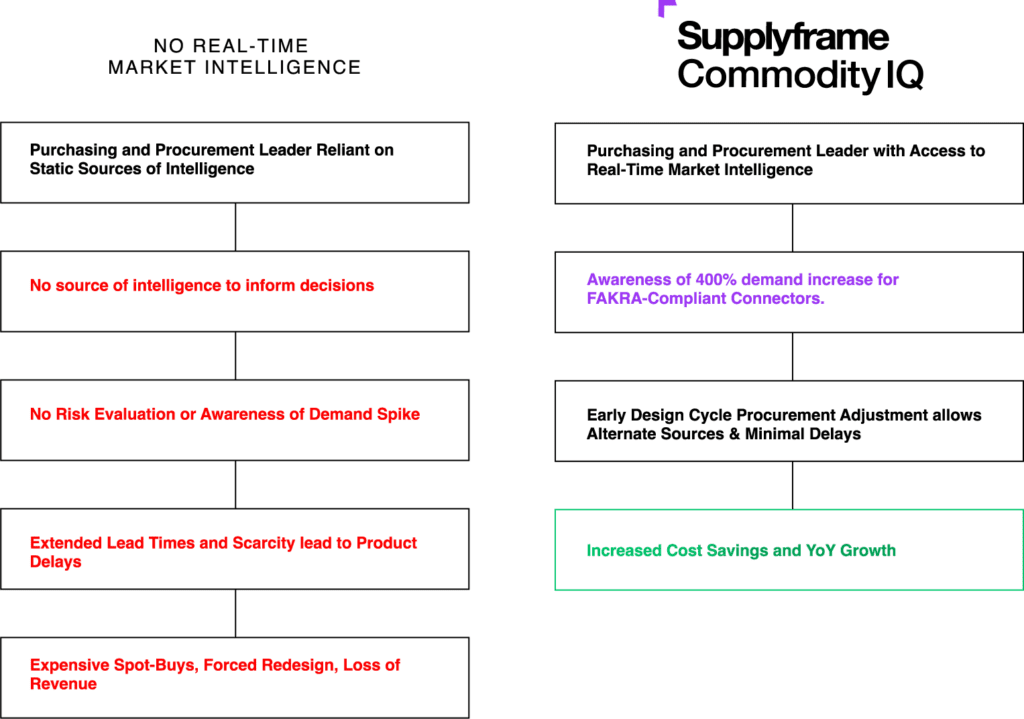- Solutions
ENTERPRISE SOLUTIONS
Infuse new product development with real-time intelligenceEnable the continuous optimization of direct materials sourcingOptimize quote responses to increase margins.DIGITAL CUSTOMER ENGAGEMENT
Drive your procurement strategy with predictive commodity forecasts.Gain visibility into design and sourcing activity on a global scale.Reach a worldwide network of electronics industry professionals.SOLUTIONS FOR
Smarter decisions start with a better BOMRethink your approach to strategic sourcingExecute powerful strategies faster than ever - Industries

Compare your last six months of component costs to market and contracted pricing.

- Platform
- Why Supplyframe
- Resources
The Industry Insights series explores aspects of the global electronics industry, diving deeper into where we stand, and how Supplyframe can help organizations tackle some of the most pressing challenges in recent decades. In the latest iteration of the series, we turn our attention to market intelligence, something that is poised for a transformed and digital approach that breaks free of static and limited reports.
With supply uncertainty reaching levels not seen in over 30 years, organizations cannot afford to gamble with their supply chain. Far too many commodity categories are pushing 52+ week lead times, and experts believe there’s no end in sight. Join us as we explore the state of the industry and a new approach to market intelligence.
The Industry is Fighting a Global Shortage With Outdated Insights
While the global landscape is incredibly volatile, and numerous factors continue to contribute to mounting risk and challenges across the supply chain, many of these issues are all pointing to the same outcome: an unprecedented chip shortage that shows no signs of slowing down.
We’ve reached a point where demand far outweighs supply. Semiconductors and advanced electronic components are found in everything from the car in your driveway, to the phone in your pocket, and throughout your household within any connected or IoT-enabled device. To put it simply, we cannot manufacture enough to go around.
While the simplest solution may be to simply increase capacity, we’ve already spent some time discussing how that’s simply not possible in the near-term, due to the inherent complexity of semiconductor production.
Could we potentially weather the storm? In this case, the answer is “not likely.” A recent article from Forrester predicted that the shortage could last until 2023:
“Because demand will remain high and supply will remain constrained, we expect this shortage to last through 2022 and into 2023.”
– Glenn O’Donnell, Vice President Research Director at Forrester
Among this, our Design-to-Source Intelligence (DSI) Network continues to show rising activities in both design and sourcing. For the month of May 2021, we noted seasonal slowdown, but overall growth in the market of 20%+ year-over-year.
Sourcing activities are focused around semiconductor devices, ICs, capacitors, resistors, and connector components. The activity is also concentrated in both the APAC and America regions, which make up 90% of overall demand in Q2 across our DSI Network.
This cycle of increasing demand and sourcing activity, paired with dwindling supply and constrained capacity across commodity groups paints a picture of where the industry stands, but it doesn’t provide any clear path forward for procurement leaders or commodity managers.
While numerous research reports are available to capture a snapshot of these issues, they don’t provide a dynamic and up-to-date look at an industry that is rapidly changing and shifting before our very eyes.
At the core of it all, the industry needs a better way to make decisions at the point of design, which is where 80% of a product’s lifetime risk is locked in during development.
What if You Had Access to Commodity Intelligence?
As a thought experiment, let’s rewind the clocks back to 2020, when the entire electronics value chain was thrown into disarray by, among other things, a global pandemic. With the demand mix changing in weeks and recovery still on the horizon, consider how you navigated the challenges and risk emerging all around you.
What fueled your decision-making? How did you know which commodities or categories of components were most at risk? What decisions did you make in those critical moments, at the point of design, to ensure resiliency?
Now, stop and ask yourself how things could have been different. What if you had greater visibility into your supply chain? What if you knew where risk was emerging, what trends were pointing to longer lead-times, and which suppliers posed the most risk as a result?

If you had up-to-date, dynamic, expert-driven intelligence on categories like active and passive components, memory, storage, and raw materials, how would that have changed your understanding of the global landscape?
You could have recognized shifts in inventory, spotted trends emerging in real-time, and pivoted your strategy as a result. Your teams could have shifted to previously identified alternates, or they could have moved to 2nd and 3rd supplier options.
You could have been agile in your decision-making, and agility leads to resiliency over time. While the past is the past, the shortages are here now, and they will be into the future. It’s time for a better approach.
Introducing Supplyframe Commodity IQ
Supplyframe Commodity IQ, is a transformed approach to market research, providing unmatched insights tailored to the electronics industry. This new solution is powered by our Design-to-Source Intelligence (DSI) Network, composed of data from over 10 million sourcing and engineering professionals.
This data, combined with additional insights from industry partners and commodity expert analysis, is surfaced through AI methods to produce actionable intelligence that lives in a dynamic, ever-evolving online environment. Gone are the days of static one-off market reports updated once a quarter. Supplyframe Commodity IQ is a true evolution, always providing the latest information that leaders need to make smarter, more agile decisions across their supply chain.
Discover a new approach to market intelligence. Discover Supplyframe Commodity IQ today.


